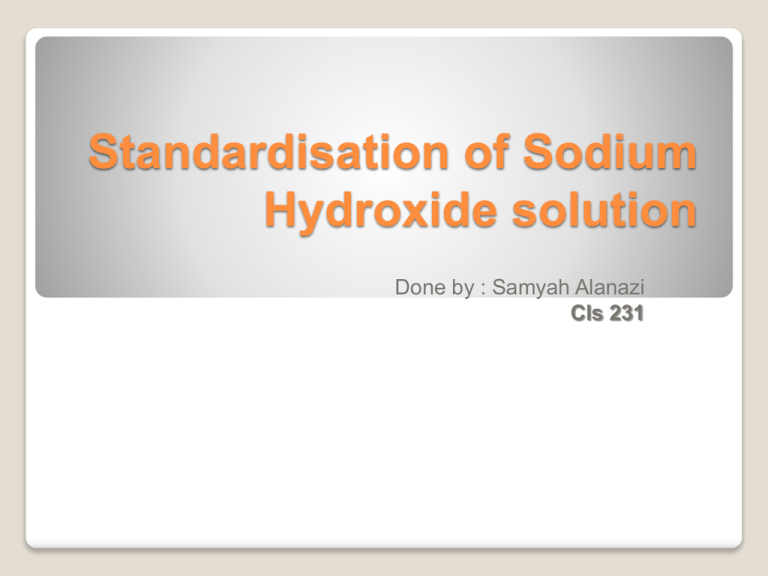Standardisation of Sodium Hydroxide solution
advertisement

Standardisation of Sodium Hydroxide solution Done by : Samyah Alanazi Cls 231 Lecture outline - What is standardisation ? Types of standard solutions. Eexperiment objective . Types of titration methods. Procedure Calculation Standardisation : The use of standard solutions to measure the concentration of unknown solution called standardisation. Standards solution: A- primary standard: is solution containing a precisely known concentration of an element or a substance. It is prepared using a standard substance . Typically it can be weighed easily, so pure that its weight is truly representative of the number of moles of substance contained such as KHP, NaCL and KH(IO3)2. Criteria of primary standard: 1- High purity. 2- Inexpensive and readily available. 3- Stable to drying temperatures, not be efflorescent nor hygroscopic. 4- High equivalent weight . For example: The potassium salt of phthalic acid, KHC8H4O4, is crystalline nonhygroscopic solid that can be readily obtained in a high state of purity. B- Secondary standard: Standards which do not meet the criteria mentioned earlier so their concentration must be determined in relative to primary standards through titration. One of these standards NaOH. NaOH contains impurities of NaCL, Na2C03 and Na2SO4 and readily absorbs H2O from the atmosphere . For mentioned reasons NaOH will be titrated against a standard weak acid such as potassium hydrogen phthalate KHC8H4O4. Objective: To determine the concentration of a solution through the standardisation of sodium hydroxide using potassium hydrogen phathlate by titration method. Concentration: The number of molecules of a substance in a given volume (expressed as moles/cubic meter) or Molar. Types of Titration methods 1-Acid-base titration: An operation, used in volumetric analysis, in which a measured amount of one solution is added to a known quantity of another solution until the reaction between the two is complete. If the concentration of one solution is known, that of the other can be calculated. 2- Back titration: An analytical chemistry technique that allows the user to find the concentration of a reactant of unknown concentration by reacting it with an excess volume of another reactant of known concentration. 3- Redox titration: (Also called oxidation-reduction titration) is a type of titration based on a redox reaction between the analyte and titrant. 4- Complexometric titration: Complexometric titration (sometimes chelatometry) is a form of volumetric analysis in which the formation of a colored complex is used to indicate the end point of a titration. Standardisation of Sodium Hydroxide solution • • 1- KHP (acid) + NaOH (base) KNaP + H2O ( reaction equation ) 2- The acid and base will react together until one of the two is completely reacted . That point called end point is called the end point that is neutral. If any additional acid or base is added, the solution will then become acidic or basic depending in which was added in excess. 3- to visualise the end point, an indicator is added to the reaction. 4- An indicator: is a chemical that changes colour at a particular pH. When just a tiny excess of an acid or base is added beyond the completion of the reaction , the indicator changes colour. The amount added from the burette at this point is called the endpoint. Reagents: 1- potassium Acid Phthalate(KHP, dried for 2 hours at 110 C). 2- Working Sodium Hydroxide Solution (0.1 M, carbonate free). 3- Phenolphthalein Indicator Solution (0.5 g in 50 ml ETOH + 50 ml H2O). Procedure: 1- Accurately weigh 0.5 grams of KHP into each of two 250 ml Erlenmeyer flasks. 2- Dissolve each sample in approximately 100 ml of distilled water (boiled and cooled). 3- Rinse a clean burette two times with 5 ml portions of the NaOH solution to be used when titrating, then titrate to the first pink colour that persists for at least 30 seconds. 4- calculate the molarity of the alkaline solution. Using basic stoichiometry, the moles of NaOH in the solution can be determined from the moles of KHP added to the reaction . From this equation : KHP (acid) + NaOH (base) KNaP + H2O For every one mole of KHP, it would be one mole of NaOH react completely. Since we weigh out a particular mass of KHP, we will use as the standard. The molecular mass of KHP IS 204.23. Moles of KHP = grams of KHP/ Molecular mass of KHP= grams of KHP/ 204.23. Calculation Moles of KHP = Moles of NaOH. The buret indicate how much NaOH is being added to the KHP . This reading will be in milliliters. Convert it to liters (liters = ml/1000). The concentration of the sodium hydroxide solution can be determined now by Molarity of NaOH = moles of NaOH/ liters of NaOH. Example: 0.8 grams of KHP is titrated with 40 ml of unknown NaOH solution. What is the molarity of the NaOH solution? Solution: Liters of NaOH = ml of NaOH / 1000 = 0.04 Liters. Moles of KHP = grams of KHP/ molecular mass of KHP = grams of KHP/ 204.23 = 0.8 grams of KHP/ 204.23 = 0.0039 moles Moles of NaOH = moles of KHP = 0.0039 moles. Molarity of NaOH = moles of NaOH / liters of NaOH = 0.0039 moles / 0.040 liters of NaOH = 0.0975 moles / liters. Questions ?






